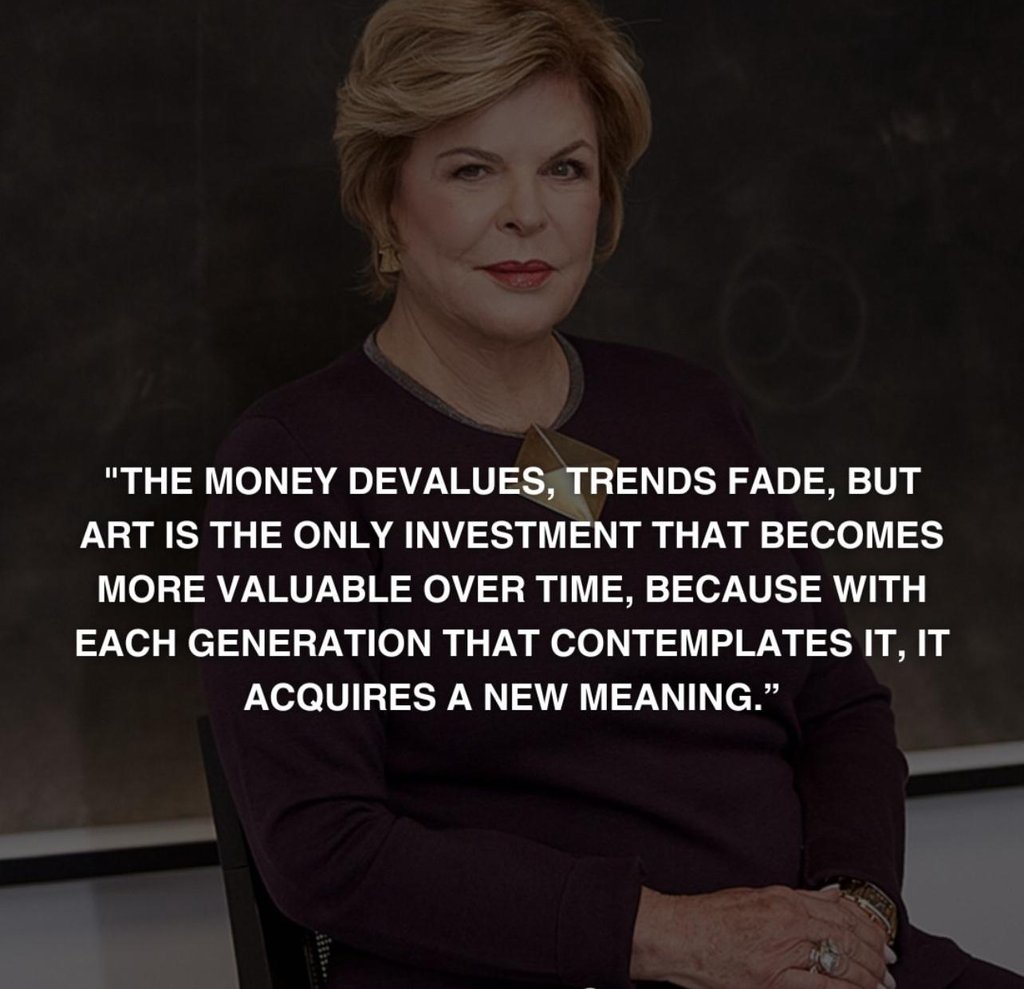Beyond Possession: Art as Care, Connection, and Custodianship.
An intimate and visionary journey through the figure of Ella Fontanals-Cisneros — collector, patron, and founder of CIFO. Not a mere biography, but a poetic and curatorial dialogue that questions the very meaning of caretaking, of letting go, and of turning art into a bridge between souls, eras, and cultures. A text that reflects on curatorship as a radical act of love, and on collecting not as possession, but as a way of caring for time and for the future.
COLLECTORS OF MEANING: WHEN ART BECOMES A RESPONSIBILITY
Charlotte Madeleine CASTELLI
6/30/20254 min read


“We do not own art. We pass through it, we accompany it, and then we let it go.”
This sentence is not merely a vision—it is a gentle invocation. And perhaps... no one has ever brought it to life so authentically as Ella Fontanals-Cisneros. There is something in her story that continues to whisper within me, like an echo that doesn’t seek attention, but truth. Ella has never been interested in ownership as conquest, but in care as vocation, she has never sought to control art, but to inhabit it, understand it, allow it to grow through her and beyond her.
In 2002, she founded CIFO, the Cisneros Fontanals Art Foundation, in Miami: not a container, but a living organism. It is here that curatorship finds its most radical form, not a neutral selection, not decorative display, but a deep, almost visceral choice. CIFO was born to support Latin American voices, to lift them from the silence and marginality to which the art world had too often confined them., but it is more than that. It is an act of trust. Every work welcomed, every artist supported, every exhibition built is a gesture that says: you exist, your voice matters, your gaze can reshape the world.
Curatorship, from this perspective, is never a technical gesture. It is a language, a gaze that becomes a thread, a listening that becomes structure. It is a practice of attention, toward the work, its energy, its capacity to question, to transform, even to unsettle, if necessary. Ella has always rejected simplifications, labels, easy narratives. She has built an institution capable of making the invisible visible, where time becomes a curatorial element: time to observe, time to educate, time to allow a vision to mature. Slowness, in a frantic and consuming system, becomes her most subversive statement.
Her collection was never conceived as an encyclopedia of art, but as an emotional map—a territory to be explored. There are works that speak the language of geometric abstraction, precise as meditations; others that stop time through photography, as if trying to hold on to a collective breath. Some stretch perception, others fragment it. But all, without exception, seem to belong to a larger project: that of narrating not art as such, but the human condition through art. The thread that connects a fragile drawing by Gego to a vibrant sculpture by Lygia Clark, or an immersive digital installation to an analog print from the 1960s, is not technique, nor market value, but intention. And intention, for Ella, is everything.
What moves me most deeply is the way she speaks of collecting—not as a desire to possess, but as an act of responsibility. “We are only temporary custodians,” she says. And in that sentence, which some might interpret as detachment, I hear instead an incredible emotional density. It means that art never truly belongs to us—it passes through us, calls to us, asks to be welcomed, protected, listened to. And then, let go, so that it may continue its journey. This is also how I understand curatorship: as a form of accompaniment, of silent presence. As a space that opens between the work and those who encounter it, allowing for dialogue.
The work of the foundation has never been to select what “works,” but what resonates. And to this day, the works of artists who found their first real listening space within CIFO continue to resonate—artists like Gustavo Pérez Monzón, who with his suspended networks traced a physics of emotional tension; or Suwon Lee, who transformed nocturnal light into an interior geography; or Judith Barry, who turned digital language into a space for meditation. There is never a straight line in this collection. There is a constellation. And within that constellation coexist diverse aesthetics, divergent sensibilities, distant eras. But all tell the same urgency: not to be forgotten.
Ella is also this: a woman who has always sought to restore value to what risked being lost to oblivion. The fact that she wrote her first novel at eighty, without concern for expectations, makes me smile and moves me deeply. Because it’s a gesture that speaks of freedom. The freedom to keep searching, to make mistakes, to dream. The freedom never to confine oneself to a role. It’s as if she’s saying: even when the body slows down, the mind can still take flight.
And her home, ultimately, is the truest manifesto of her philosophy. Not a sterile temple, but a lived-in space, where art becomes part of daily life. The paintings are not there to be admired, but to be listened to. The works live alongside the rooms, the smells, the gestures. And that, to me, is the greatest dream: that art is not a luxury, but a breath. That it may inhabit our days like a question, like a possibility.
Ella Fontanals-Cisneros has built far more than a collection. She has built a vision of the world. And if today I feel that curatorship is not just a profession, but a radical form of care, it is also thanks to her.
Because curatorship, in its deepest sense, is love that does not cling—but liberates.
And perhaps the real question, the one that confronts us as curators, as spectators, as human beings, is this:
Are you capable of letting go of what you love, so that it may continue to live through someone else?
© Charlotte Madeleine Castelli | All rights reserved
